Hoe kunnen we helpen?
New assignment
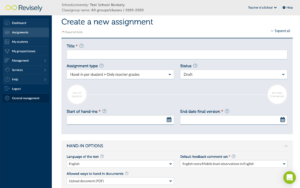
Choose a title that says something about the assignment so that you can later easily find the correct assignment based on the title.
Then you make a choice in the field ‘Assignment type‘. You can choose from the standard possibility of sending out an assignment to students, a peer grading assignment, an assignment that has to be made in teams or an assignment that is both a peer grading and team assignment.
The Peer grading option ensures that the students can provide each other’s submitted texts with feedback. As a teacher you keep an overview and you may or may not include the feedback from peers in the final assessment of an assignment. The system automatically creates random student combinations that provide feedback to the work of another student.
The option of Team hand-in. Here the students are randomly put in a team of 2 or more team members. As a teacher you can also edit the teams and/or make your own team devision. Team hand-in assignment allows students to jointly submit one assignment that is afterwards also corrected, assessed and provided with feedback by the teacher.
The status of the assignment can be draft/published/closed/hidden. You can always change this later. For example, it is possible to prepare various assignments before you publish them. When you choose ‘published’ here, the assignment will be send immediately to your students once you have finished creating the assignment. Otherwise, you can send the assignment on a later time by going to ‘Assignments’ in the menu on the left and click on the icon with the three dots of the assignment in question and to click on ‘Modify Assignment’. Then you can change the status of the assignment to ‘Published’.
The start and end date and time speak for themselves.
The ‘language of the text’ determines which database of observations will be used to check and give feedback on the text. At the moment, databases with observations specifically for the Dutch, English or Spanish language are available. With English you can choose to give feedback on the level of advanced English, basic English or in Dutch. This way you can do justice to the differences between students of different levels and different school years.
Under the option ‘Way to hand in texts’ you can choose whether your students type their texts in Revisely (or copy and paste them from their word/pages file), or that they upload a document in Revisely. These can be different file formats but we recommend that your students upload it as a PDF file to ensure that the file will look the same in Revisely after uploading it.
The option ‘Accept hand-ins after the deadline‘ speaks for itself.
At general settings, you can indicate whether your students receive an extra notification by email when the assignment is published and whether they receive automatic reminders.
Plagiarism check indicates whether the plagiarism check is switched on for this assignment. This is an additional (paid) option in Revisely. Within Revisely, there is seamless integration with the plagiarism checker of Urkund, whereby submitted texts are compared with a database of websites, texts and other sources that may have been used in the assignment. When there is a part of the text that has been copied from somewhere, you can see exactly which part of an original source is used. That way you can decide for yourself what you want to do with this information.
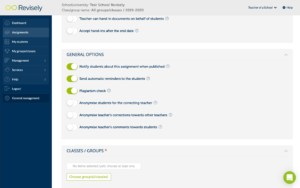
You can select your preferences at the General options page. All options (as shown in the image above) speak for themselves.
Then, select the classes for which this assignment should apply.
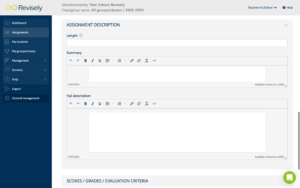
You can indicate the length of the assignment at your own discretion. This is for example “2 pages”, “120-16 words” or “no more than one A4”.
At summary you can give a short description about the assignment and at the Full description more specific instruction as you wish. Both fields are visible for a student when making the assignment.
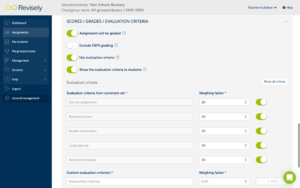
The options ‘Assignment will be graded’ and ‘Include CEFR grading’ speak for themselves.
The option ‘Use evaluation criteria‘ and ‘Show evaluation criteria to students‘ determines whether evaluation criteria are used for this assignment and whether students will be able to see which criteria are used to assess the assignment. These criteria or categories are explained below.
Under the heading ‘scores/grades/criteria‘ you will find the different criteria on which you are going to assess an assignment. Revisely has 7 standard criteria and you can add up to 5 own assessment criteria yourself. The standard criteria correspond to the categories in which the observations are classified in the database. More information about the database of observations can be found under the ‘observation database’. Here you can also choose the weighting of the chosen criteria. Just make sure the total adds up to 100%.
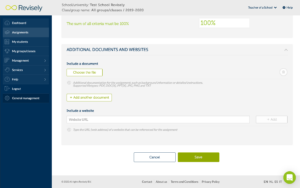
Finally you can add relevant documents and websites. This can be an article that students have to write their assignment about or a video or audio fragment in which arguments can be found. Any form of digital documentation is possible here.
As soon as you click on ‘save‘ and you have selected the option at ‘status’ (at the top of the page) that students will automatically receive a message as soon as the assignment has been published, the students will immediately receive a notification. If not, remember that the assignment is saved but that students are not able to start their assignments yet. If you would like to publish the assignment on a later time, go to the assignment (via ‘Assignments’ in the menu on the left) and click on the button with the three dots. Then click on ‘Modify assignment’ and change at ‘status’ the assignment to ‘published’.
The students have now received a message about the new assignment. This message will be sent by e-mail. In this e-mail message they find a link and by clicking on the link they are immediately directed to the assignment.
After publication, it is still possible to make changes to the assignment to a limited extent. It is also possible to make a copy of an assignment and give it to another class. This is possible by Modifying the assignment as is explained above.
If you want to give a new assignment to your students, select on the Dashboard page the big green button with ‘New assignment‘.
You will see a pop-up screen with a selection of assignment templates. Here you can choose an assignment template. This can save even more time since you can easily choose a template when you want the students to do an assignment similar to an existing template. This could be an assignment template to write an essay or about a chapter of the book you discussed. You can create these templates yourself and save them within Revisely so that you can always easily find the assignment and send it to a new group of students.
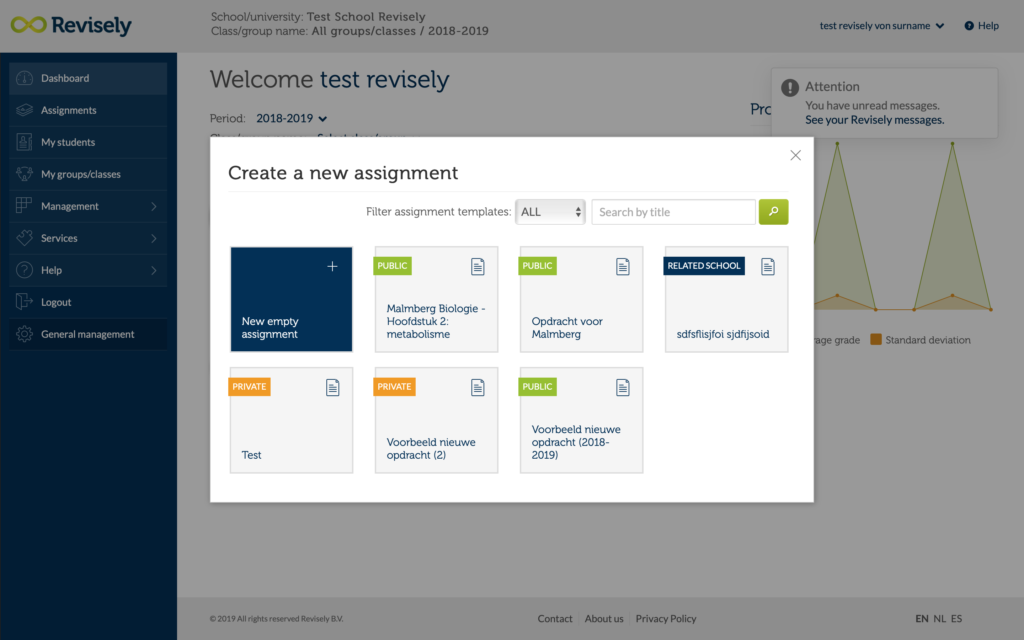
Choose ‘New Empty Assignment‘ if you want to start with an empty assignments form. You will see the screen below. Here you can fill in all the details and instructions for an assignment that your students have to make. You can type information about how to do the assignment successfully and to submit it on time. All fields with a * must be completed.

Choose a title that says something about the assignment so that you can later easily find the correct assignment based on the title.
Then you make a choice in the field ‘Assignment type‘. You can choose from the standard possibility of sending out an assignment to students, a peer grading assignment, an assignment that has to be made in teams or an assignment that is both a peer grading and team assignment.
The Peer grading option ensures that the students can provide each other’s submitted texts with feedback. As a teacher you keep an overview and you may or may not include the feedback from peers in the final assessment of an assignment. The system automatically creates random student combinations that provide feedback to the work of another student.
The option of Team hand-in. Here the students are randomly put in a team of 2 or more team members. As a teacher you can also edit the teams and/or make your own team devision. Team hand-in assignment allows students to jointly submit one assignment that is afterwards also corrected, assessed and provided with feedback by the teacher.
The status of the assignment can be draft/published/closed/hidden. You can always change this later. For example, it is possible to prepare various assignments before you publish them. When you choose ‘published’ here, the assignment will be send immediately to your students once you have finished creating the assignment. Otherwise, you can send the assignment on a later time by going to ‘Assignments’ in the menu on the left and click on the icon with the three dots of the assignment in question and to click on ‘Modify Assignment’. Then you can change the status of the assignment to ‘Published’.
The start and end date and time speak for themselves.
The ‘language of the text’ determines which database of observations will be used to check and give feedback on the text. At the moment, databases with observations specifically for the Dutch, English or Spanish language are available. With English you can choose to give feedback on the level of advanced English, basic English or in Dutch. This way you can do justice to the differences between students of different levels and different school years.
Under the option ‘Way to hand in texts’ you can choose whether your students type their texts in Revisely (or copy and paste them from their word/pages file), or that they upload a document in Revisely. These can be different file formats but we recommend that your students upload it as a PDF file to ensure that the file will look the same in Revisely after uploading it.
The option ‘Accept hand-ins after the deadline‘ speaks for itself.
At general settings, you can indicate whether your students receive an extra notification by email when the assignment is published and whether they receive automatic reminders.
Plagiarism check indicates whether the plagiarism check is switched on for this assignment. This is an additional (paid) option in Revisely. Within Revisely, there is seamless integration with the plagiarism checker of Urkund, whereby submitted texts are compared with a database of websites, texts and other sources that may have been used in the assignment. When there is a part of the text that has been copied from somewhere, you can see exactly which part of an original source is used. That way you can decide for yourself what you want to do with this information.

You can select your preferences at the General options page. All options (as shown in the image above) speak for themselves.
Then, select the classes for which this assignment should apply.

You can indicate the length of the assignment at your own discretion. This is for example “2 pages”, “120-16 words” or “no more than one A4”.
At summary you can give a short description about the assignment and at the Full description more specific instruction as you wish. Both fields are visible for a student when making the assignment.

The options ‘Assignment will be graded’ and ‘Include CEFR grading’ speak for themselves.
The option ‘Use evaluation criteria‘ and ‘Show evaluation criteria to students‘ determines whether evaluation criteria are used for this assignment and whether students will be able to see which criteria are used to assess the assignment. These criteria or categories are explained below.
Under the heading ‘scores/grades/criteria‘ you will find the different criteria on which you are going to assess an assignment. Revisely has 7 standard criteria and you can add up to 5 own assessment criteria yourself. The standard criteria correspond to the categories in which the observations are classified in the database. More information about the database of observations can be found under the ‘observation database’. Here you can also choose the weighting of the chosen criteria. Just make sure the total adds up to 100%.

Finally you can add relevant documents and websites. This can be an article that students have to write their assignment about or a video or audio fragment in which arguments can be found. Any form of digital documentation is possible here.
As soon as you click on ‘save‘ and you have selected the option at ‘status’ (at the top of the page) that students will automatically receive a message as soon as the assignment has been published, the students will immediately receive a notification. If not, remember that the assignment is saved but that students are not able to start their assignments yet. If you would like to publish the assignment on a later time, go to the assignment (via ‘Assignments’ in the menu on the left) and click on the button with the three dots. Then click on ‘Modify assignment’ and change at ‘status’ the assignment to ‘published’.
The students have now received a message about the new assignment. This message will be sent by e-mail. In this e-mail message they find a link and by clicking on the link they are immediately directed to the assignment.
After publication, it is still possible to make changes to the assignment to a limited extent. It is also possible to make a copy of an assignment and give it to another class. This is possible by Modifying the assignment as is explained above.
